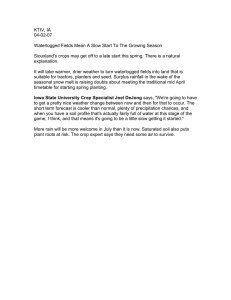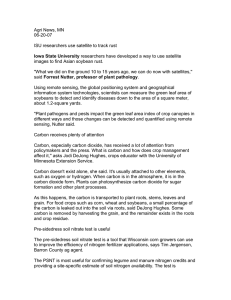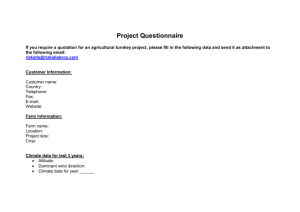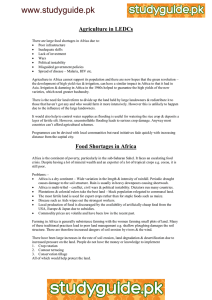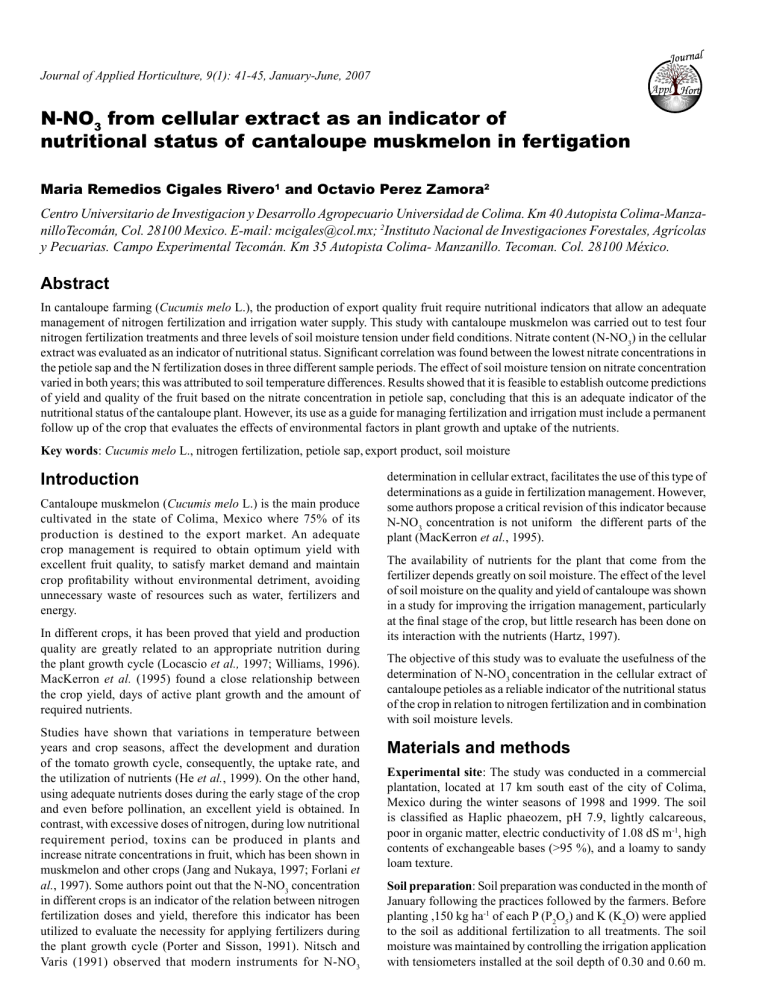
Journal of Applied Horticulture, 9(1): 41-45, January-June, 2007 Appl N-NO3 from cellular extract as an indicator of nutritional status of cantaloupe muskmelon in fertigation Maria Remedios Cigales Rivero1 and Octavio Perez Zamora2 Centro Universitario de Investigacion y Desarrollo Agropecuario Universidad de Colima. Km 40 Autopista Colima-ManzanilloTecomán, Col. 28100 Mexico. E-mail: mcigales@col.mx; 2Instituto Nacional de Investigaciones Forestales, Agrícolas y Pecuarias. Campo Experimental Tecomán. Km 35 Autopista Colima- Manzanillo. Tecoman. Col. 28100 México. Abstract In cantaloupe farming (Cucumis melo L.), the production of export quality fruit require nutritional indicators that allow an adequate management of nitrogen fertilization and irrigation water supply. This study with cantaloupe muskmelon was carried out to test four nitrogen fertilization treatments and three levels of soil moisture tension under eld conditions. Nitrate content (N-NO3) in the cellular extract was evaluated as an indicator of nutritional status. Signicant correlation was found between the lowest nitrate concentrations in the petiole sap and the N fertilization doses in three different sample periods. The effect of soil moisture tension on nitrate concentration varied in both years; this was attributed to soil temperature differences. Results showed that it is feasible to establish outcome predictions of yield and quality of the fruit based on the nitrate concentration in petiole sap, concluding that this is an adequate indicator of the nutritional status of the cantaloupe plant. However, its use as a guide for managing fertilization and irrigation must include a permanent follow up of the crop that evaluates the effects of environmental factors in plant growth and uptake of the nutrients. Key words: Cucumis melo L., nitrogen fertilization, petiole sap, export product, soil moisture Introduction Cantaloupe muskmelon (Cucumis melo L.) is the main produce cultivated in the state of Colima, Mexico where 75% of its production is destined to the export market. An adequate crop management is required to obtain optimum yield with excellent fruit quality, to satisfy market demand and maintain crop protability without environmental detriment, avoiding unnecessary waste of resources such as water, fertilizers and energy. In different crops, it has been proved that yield and production quality are greatly related to an appropriate nutrition during the plant growth cycle (Locascio et al., 1997; Williams, 1996). MacKerron et al. (1995) found a close relationship between the crop yield, days of active plant growth and the amount of required nutrients. Studies have shown that variations in temperature between years and crop seasons, affect the development and duration of the tomato growth cycle, consequently, the uptake rate, and the utilization of nutrients (He et al., 1999). On the other hand, using adequate nutrients doses during the early stage of the crop and even before pollination, an excellent yield is obtained. In contrast, with excessive doses of nitrogen, during low nutritional requirement period, toxins can be produced in plants and increase nitrate concentrations in fruit, which has been shown in muskmelon and other crops (Jang and Nukaya, 1997; Forlani et al., 1997). Some authors point out that the N-NO3 concentration in different crops is an indicator of the relation between nitrogen fertilization doses and yield, therefore this indicator has been utilized to evaluate the necessity for applying fertilizers during the plant growth cycle (Porter and Sisson, 1991). Nitsch and Varis (1991) observed that modern instruments for N-NO3 determination in cellular extract, facilitates the use of this type of determinations as a guide in fertilization management. However, some authors propose a critical revision of this indicator because N-NO3 concentration is not uniform the different parts of the plant (MacKerron et al., 1995). The availability of nutrients for the plant that come from the fertilizer depends greatly on soil moisture. The effect of the level of soil moisture on the quality and yield of cantaloupe was shown in a study for improving the irrigation management, particularly at the nal stage of the crop, but little research has been done on its interaction with the nutrients (Hartz, 1997). The objective of this study was to evaluate the usefulness of the determination of N-NO3 concentration in the cellular extract of cantaloupe petioles as a reliable indicator of the nutritional status of the crop in relation to nitrogen fertilization and in combination with soil moisture levels. Materials and methods Experimental site: The study was conducted in a commercial plantation, located at 17 km south east of the city of Colima, Mexico during the winter seasons of 1998 and 1999. The soil is classied as Haplic phaeozem, pH 7.9, lightly calcareous, poor in organic matter, electric conductivity of 1.08 dS m-1, high contents of exchangeable bases (>95 %), and a loamy to sandy loam texture. Soil preparation: Soil preparation was conducted in the month of January following the practices followed by the farmers. Before planting ,150 kg ha-1 of each P (P2O5) and K (K2O) were applied to the soil as additional fertilization to all treatments. The soil moisture was maintained by controlling the irrigation application with tensiometers installed at the soil depth of 0.30 and 0.60 m. 42 N-NO3 from cellular extract as an indicator of nutritional status of cantaloupe muskmelon in fertigation The soil temperature was registered daily. Experimental design: A divided blocks experimental design was implemented in the eld. Three sub-plots at soil moisture tensions of 10, 20, and 45 kPa constituted each block or main plot. Each main plot was divided into four small plots (Latin arrangement) for the application of nitrogen treatments: 0, 80, 120, and 160 kg N ha-1. Each treatment was replicated four times. The variety of cantaloupe evaluated was the hybrid Ovation. The cellular sap extractions to evaluate the N-NO3 concentrations were carried out at the following phenological stages: blossom, fruiting and ripening stages. The samples were collected according to the Warncke’s methodology (Warncke,1997). In order to have a representative sample of each treatment, 8 or 10 petioles were collected in each of the 12 small plots and were stored immediately at 4ºC temperature until the laboratory analysis. The total fruit yields were registered in each treatment. Fruit quality was evaluated using the sugar content (ºBrix) and the fruit size as indicators. In this last indicator, ve groups were considered according to the market criteria. Results were analyzed using ANOVA procedures and linear regression with the statistics software STATISTIX (1998) Results and discussion Effect of nitrogen applied to soil: The statistical analysis showed that the effect of nitrogen fertilization treatments was not similar in the two years of study. For 1998, only in the rst stage of the cycle (43 days after sowing), signicant differences were registered among treatments while, in 1999, signicant differences were registered at all three crop stages (28, 49 and 63 days after planting) (Table 1). The values of correlation between the N quantities applied to the soil and the N-N03 concentrations in the cellular extract varied in the crop stages. In 1998, only at blooming stage, a high correlation coefcient was observed (r=0.88). In contrast, during 1999, at all three sampling stages, correlation coefcients were signicant (r = 0.90, 0.92, and 0.95, respectively). Similar variations have been reported in other horticultural crops when these variables correlate as function of time. (Andersen et al.,1999; Kubota et al., 1997; Rhoads et al., 1996; Waterer, 1997). These results indicate that variations of correlation values depend on the age of the crop (sampling date). The differences in correlation values found in our study between 1998 and 1999 were related to the N-N03 level in the petiole sap. During 1998, the average of N-NO3 concentrations was 1919 mg L-1 and for 1999 was 1316 mg L-1 (Table 2). In the rst year, the lowest N-N03 level occurred at the harvest stage (6 days after sowing). At this date, high correlation was observed. Some authors have observed that increase and decrease of N-NO3 concentration in the rst and nal crop stages, are characteristic of species (MacKerron et al., 1995). The age intervals in which applied doses of N and N-N03 concentration in the petiole sap correlated, depends on this characteristic that explains variations in correlation values for different ages and crops. Besides this, other factors like the space variability for N-N03 concentrations among plant parts necessitate a critical revision of the use of N-N03 concentration in the petiole sap as a guide to optimize fertilization (Mackerron et al., 1995; Meyer and Marcus, 1998). Applied water effect: Even though the effect attributed to the soil moisture treatments on the N-N03 concentration proved to be signicant (P< 0.01) for every crop stage during the rst year of study, in the second year the effect was signicant only in the earliest stage of the crop, which is the most important stage for N decits correction of the plant (Pérez-Zamora et al., 2004). The increase of N-N03 related to the applied N varied with the soil moisture tension. In 1998, this increase was observed for 45 kPa treatment (Table 2). These results were attributed to the differences in soil temperature between both crop cycles: in 1998, a low level of soil moisture tension caused high concentration of N-N03. Considering that the humidity levels in treatments were kept within the adequate humidity range for cantaloupe, the high concentration of N-N03 in the petioles of the highest humidity treatment (10kPa) is explained by the effect the soil temperature registered in 1999 over the uptake rate and because the N03 moves in the soil mainly due to mass ow. Reports are available that low humidity levels contribute to accumulation of nitrogen in the petioles of potato plants (Middleton et al., 1975), also a lack of consistency in the correlation between humidity and concentration of nitrates is reported (Kubota et al., Table1. Analysis of variance summary for the N-N03 concentrations (mg L-1) in cantaloupe petioles for N doses and soil moisture tension levels. Source of variation Degree of freedom 43 1998 DAS1 50 63 28 1999 DAP2 49 63 Main Plots Rows 3 NS NS NS NS NS NS Columns 3 NS NS NS NS NS NS Nitrogen 3 ** NS NS ** *** *** Error a 6 ** *** *** ** NS NS NS NS NS * ** NS 9.39 8.63 8.87 12.82 14.22 Soil moisture 2 Error b 6 Nitrogen x Soil moisture 6 Error 18 C. V. (%) 9.37 1 2 *, ** and *** are signicant at P=0.05, 0.01, and 0.001, respectively; NS=not signicant; DAS= day after sowing; DAP= days after planting N-NO3 from cellular extract as an indicator of nutritional status of cantaloupe muskmelon in fertigation 43 Table 2. Concentrations of N-NO3 (mg L-1) in the cellular extract from cantaloupe petioles under four nitrogen doses and three soil moisture tensions at three crop stages Treatments N (kg ha-1) 0 80 120 160 LSD (P=0.05) Crop Stages Soil moisture tension (k Pa) 1998 1999 Blooming Fruiting Ripening Blooming Fruiting Ripening 10 1944 1944 1469 1763 1017 678 25 2260 1808 1310 1831 1130 678 45 2011 2290 1898 1492 859 746 10 2034 2035 1672 1893 1198 927 25 2260 1695 1536 1863 1288 881 45 2290 2215 2011 1559 927 859 10 2011 1853 1582 2237 1537 1175 25 2280 1831 1401 1695 1220 1107 45 2300 2214 2124 1695 1356 1041 10 1763 1808 1536 2057 1175 1153 25 1831 1831 1469 1763 1424 1006 45 2300 2011 2260 1695 1288 1107 262 275 311 238 240 223 1997). In the case of cantaloupe muskmelon such report that the humidity effect on the N-N03 concentration in the petiole sap, does not exist. Interaction of nitrogen fertilization and soil moisture: The effect of the nitrogen interaction with mositure was signicant for samples at blooming and fructication in 1998, but it was not consistent under the different doses of fertilization in both crop cycles (Table 2). This contrasts with the results obtained in studies with potato crop, in which it is observed that an optimum combination of nitrogen and soil moisture during the plant growth cycle results in a high correlation with the N-N03 concentrations in the petioles during the whole plant growth cycle (Porter and Sisson, 1991). Soil temperature and N-NO 3 concentrations: The pattern of soil temperature was different between the study years. In 1998, temperature average was 27.5ºC and showed a tendency to increase from the beginning of the crop cycle, in the month of February, until the end of the crop in the month of May. In 1999, temperature average was 25.5ºC and registered a decline during the rst crop stage which was strongest during the blooming and fructication stages in the months of March and April. In the rst year the N-N03 concentrations in the cellular extract of all treatments were superior to those of the second year, which showed the relation between temperature pattern and N-NO 3 concentration level. Although the effect of the soil temperature on the utilization ability of N available from the cantaloupe crop has not been studied in detail. However, in other horticultural crops, the season effect has been observed on the N-N03 cellular extract levels, and the yield and quality of the fruit (Meyer and Marcus, 1998; He et al., 1999). In this study, the differences between soil temperature patterns for study years, were related with the nitrate level in the cellular extract. Effect of N-N03 concentration on the yield and fruit quality: The effect of the N-N03 concentrations on the total production and fruit size was estimated indirectly through response functions of N applied to the soil and the production, and from applied N to the soil and concentration of N-N03. Maximum N-NO3 concentration in the petiole sap, was obtained with 70 kg N ha-1 and 17 kPa, while the maximum yield and fruit size was also obtained with the same N and soil moisture tension indicated for the N-NO3 concentration; this means that N-NO3 concentration in the petiole sap is an indicator of yield and fruit size. The results show that it is possible to establish predictions with r = 90% or higher. The production function (total yield of export fruit) for the average of two crop cycles was as following: Yield (Mg ha-1) = 60.92 - 0.126x - 1.124y + 0.00039x2 + 0.0144y2 + 0.00128xy; with r = 0.90 The response surface that considers the production of fruit size 9 and 12 (export size) is shown in Fig. 1. These results coincide with reported values in other crops by authors when yield was correlated with the N-N03 concentration in the petiole sap. They showed that the harvest stage has an effect over the correlation value, in general high “r” values (0.74 to 0.89) were reported (Andersen, 1999; Dow and Roberts, 1982; Meyer and Marcus, 1998; Rhoads et al., 1996; Williams, 1996). The fruit quality was evaluated taking the fruit size and the sugar content (ºBrix) as indicators. There were not any signicant difference among treatments as far as sugar content is concerned. However, the tendency was to diminish from 10 to 9.2ºBrix when the soil moisture level rose to 10 kPa which is the moisture tension value in which maximum production (80 Mg ha-1) of export fruit was obtained. The results of this research contrasted with the results of other authors who did not nd moisture effect or N effect on the soluble solids concentration in watermelon (Singh and Naik, 1989; Pier and Doerge, 1995). The level of N-N03 in petiole sap was related to production and the size distribution was 44 N-NO3 from cellular extract as an indicator of nutritional status of cantaloupe muskmelon in fertigation The N-NO3 concentrations reect the effects of the interactions between N fertilization and soil moisture. An adjustment programme during the crop cycle must take in consideration both factors in order to maintain these concentrations in adequate ranges. Soil moisture tension (kPa) References Andersen, P.C., F.M. Rhoads, S.M. Olson and B.V. Brodbeck, 1999. Relationships of nitrogenous compounds in petiole sap of tomato to nitrogen fertilization and the value of these compounds as a predictor of yield. HortScience, 34(2): 254-258. Dow, A.I. and S. Roberts, 1982. Proposal. Critical nutrients rangs for crop diagnosis. Agronomy. Journal, 74: 401-403. Forlani, L., S. Grillenzoni, E. Ori and P. Resca, 1997. Nitrate levels in vegetables that may be eaten raw. Italian Journal of Food Sciences, 9(1): 65-69. Hartz, T.K. 1997. Effect of drip irrigation scheduling on muskmelon yield and quality. Scientia Horticulturae, 69(2): 117- 122. -1 Nitrogen added to soil (kg ha ) Fig.1. Response surface for cantaloupe melon, sizes 9 and 12. Lines contours are yields in Mg ha-1. Jang, H.G. and A. Nukaya, 1997. Relationships between concentration of nutrient solution and uptake of nutrients in muskmelon grown in Rockwool. Journal of the Japanese Society for Horticultural Science, 66(2): 307-312. 30 1998 1999 Yield Mg ha -1 25 He, Y.Q., S. Terabayashi, T. Asaka and T. Namiki, 1999. Effect of restricted supply of nitrate on fruit growth and nutrient concentrations in the petiole sap of tomato cultured hydroponically. Journal of Plant Nutrition, 22(4-5): 799-811. Kubota, A., T.L. Thompson, T.A. Doerge and R.E. Godin, 1997. A petiole sap nitrate test for broccoli. Journal of Plant Nutrition, 20(6): 669-682. 20 15 Locascio, S.J., G.J. Hochmuth, F.M. Rhoads, S.M. Olson, A.G. Smajstrla and E.A. Hanlon, 1997. Nitrogen and potassium application scheduling effects on drip irrigated tomato yield and leaf tissue analysis. HortScience, 32(2): 230- 235. 10 5 0 9 12 15 Fruit size 18 23 Fig. 2. Distribution by size of cantaloupe production, during two consecutive crop cycles under N fertilization and different soil moisture treatments. strongly different for the extreme sizes, but not for intermediate size (No. 15), in both experimental cycles (Fig. 2). The highest correlation values were obtained between the N-NO3 concentration and the blossom stage, and the sizes 9 and 12 (r= 0.77 and r= 0.82, respectively). High correlation values between N-NO3 concentration and the production quality (taken size as indicator) have been reported for tomato crop under eld and greenhouse conditions (Anderson et al., 1999; He et al., 1999). The results in this study showed that the N-NO3 concentration in the sap petioles of the cantaloupe plant is an adequate indicator of the nutritional status of the plant and therefore constitute a useful instrument in the prediction of nal yield and production quality. The N-NO3 analysis as a guide for management of the N fertilization and soil moisture requires a crop follow up at different stages and in different climatic conditions. It is necessary to consider the environmental conditions affecting the N absorption from soil. Mackerron, D.K.L., M.W. Young and H.V. Davies, 1995. A critical assessment of the value of petiole sap analysis in optimizing the nitrogen nutrition of the potato crop. Plant and Soil, 172: 247-260. Meyer, R.D. and D.B. Marcus, 1998. Potato yield, petiole nitrogen and soil nitrogen response to water and nitrogen. Agronomy. Journal, 90: 420-429. Middleton, J.E., S. Roberts, D.W. James, T.A. Cline, B.L. McNeal and B.L. Carlile, 1975. Irrigation and fertilizer management for efcient crop production on a sandy soil. Washington State Univ. Coll. of Agric. Res. Ctr. Bull., 811. Nitsch, A. and E. Varis, 1991. Nitrates estimates using the Nitrachek test for precise N fertilization during plant growth and, after harvest for quality testing potato tubers. Potato Research, 34: 95-105. Pérez-Zamora, O., M.R. Cigales Rivero and M. Orozco Santos y Pérez-Castro K. 2004. Tensión de humedad del suelo y fertilización nitrogenada en melón cantaloupe: Part II. Agrociencia, 38(3): 261271 Pier, J.W. and T.A. Doerge, 1995. Nitrogen and water interactions in trickle - irrigated watermelon. Soil Sci. Soc. Am. J., 59: 145-150. Porter, G.A. and J.A. Sisson, 1991. Response of Russet Burbank and Seepody potatoes for nitrogen fertilizer in two cropping systems. American Potato Journal, 68: 425-443. Rhoads, F.M., S.M. Olson, G.J. Hochmuth and E.A. Hanlon, 1996. Yield and petiole-sap nitrate levels of tomato with N rates applied preplant or fertigated. Soil and Crop Science Society of Florida Proceedings, 55: 9-12. Statistix, 1998. User´s Manual. Analytical Software. Florida, 333 p. N-NO3 from cellular extract as an indicator of nutritional status of cantaloupe muskmelon in fertigation Singh, R.V. and L.B. Naik,1989. Response of watermelon (Citrullus lanatus (Thunb) Monsf.) to plant density, nitrogen and phosphorus fertilization. Indian Journal of Horticulture, 46(1): 80-83. Warncke, D. 1997. Petiole sap nitrate guidelines for selected vegetable crops. Michigan State University Extension Vegetable. CAT Alerts 1994-1998.10p. 45 Waterer, D. 1997. Petiole sap NO3-N testing as a method for monitoring nitrogen nutrition of potato crop. Canadian Journal of Plant Science, 77(2): 273-278. Williams, C.M.J. 1996. Assessment of the nitrogen and potassium status of irrigated Brussels sprouts (Brassica oleracea L. var. Genunifera) by plant analysis. Australian Journal of Experimental Agriculture, 36(7): 887-895.
